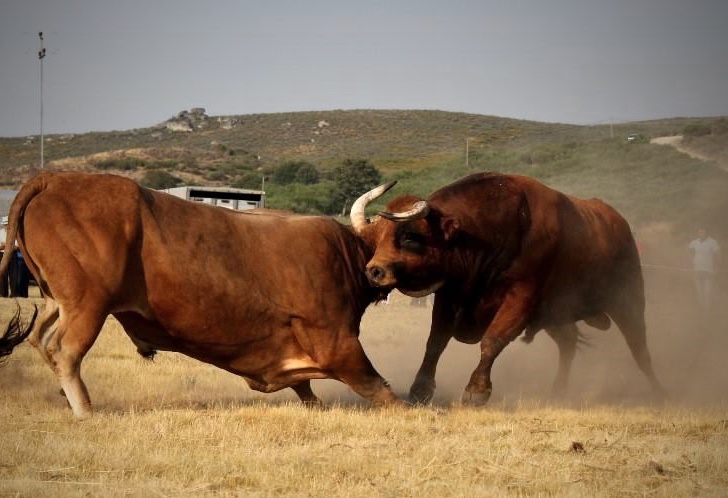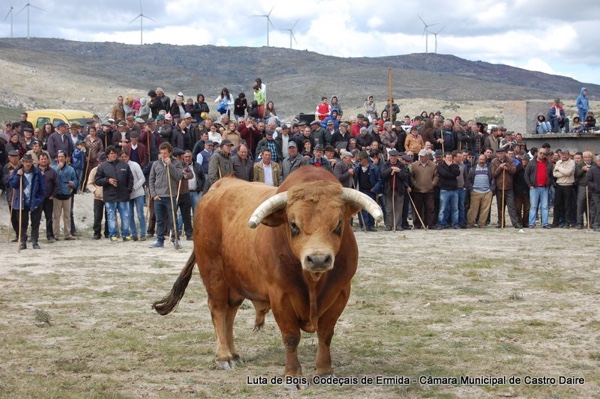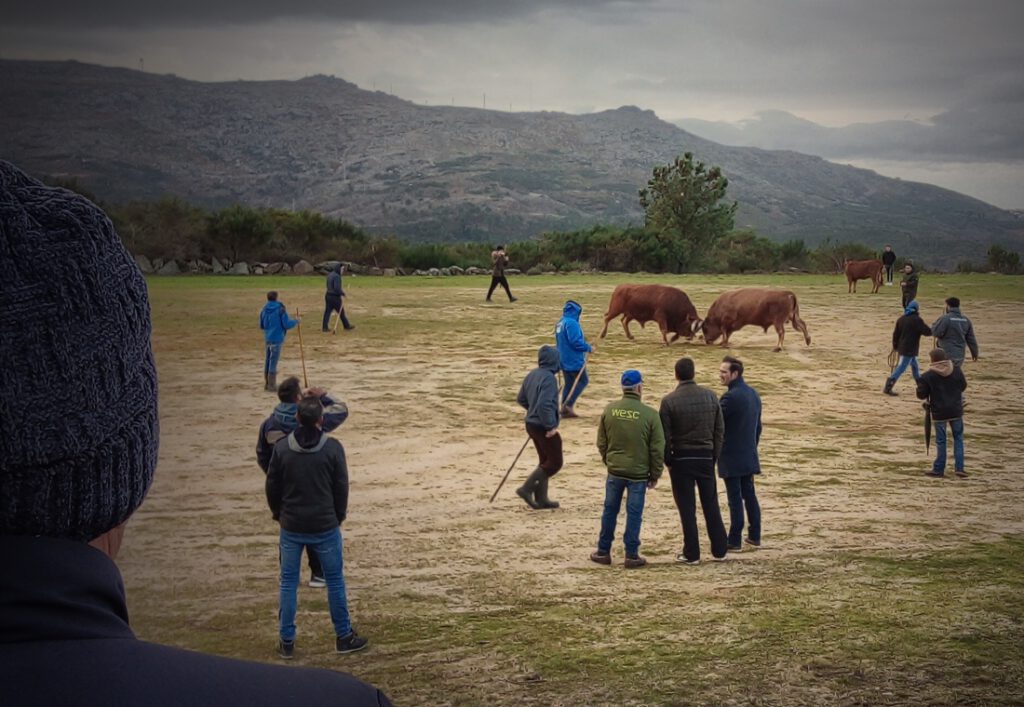Happily, on arrival, we see a familiar face. It is of a kind man from the area and whenever we meet him, we usually chat. Today he is together with his 11-year-old daughter. In the lee of an earthen wall, they have found a nice spot to watch the ‘lutas de bois’, i.e. the bullfights.
Lutas de bois
Lutas are part of the traditions of the Serra de Montemuro, the mountains we live against.
They are usually organised in summer and the rules are simple. Between 10 and 16 bulls are brought to a bullfight field on the day of the race. Each truck carries a bull and one of the female cows from his flock. Every round, two bulls are released onto the field. And by nature, the bulls will fight the competitor to protect their female. The fight continues until one of the bulls flees, who then loses the fight.

The 11-year-old girl gets a bit scared when one of the bulls runs off. About 80 metres from us, he reaches the same earthen wall on which we are sitting. The man reassures her and indeed the owner manages to catch and leash the bull. But, he explains, sometimes it can be dangerous: if a bull flees towards the bystanders and the other furiously chases after him. Then the spectators need to run off and someone might fall.
That all sounds far more spectacular than what we see today. Yes, the bulls are impressive but they remain quite mellow when brought to the arena by their owner on a leash. The rope is calmly taken off, after which the bull is usually looking around somewhat languidly and peacefully.
We even witness a round in which two bulls, although busily roaring and bellowing, don’t take on the fight. Spectators hit the ground with their sticks and poke a bit at the bulls, but they are not into it. And so the round remains uncontested.
A round later, there is a bit more spectacle. One unleashed bull runs straight at the other and soon they are headbutting each other. And as they do so, suddenly a female cow also runs onto the field, followed by a couple of men trying to catch her. However, the bulls continue their fight undisturbed. And after a few minutes, the young cow is cornered. Everyone laughs and no one panics.
All in all, it’s a pleasant get-together. Despite the cold wind and threatening rain, a few hundred people have gathered on this former football field in the middle of nowhere. Some stay in their cars and others keep themselves warm with a drink. The ‘Lutas’ are a good reason for the community to come together on this last day of the year.
The bulls are not agitated, they look well cared and there is no betting on the outcome.
Our neighbour tells us that there are no prizes to be won today. That is different during the competition season (summer). Then the winner of each round gets a prize, such as a presunto ham, a bottle of liquor or a cash prize. At the end of the competition, the bull with the most wins of the season is declared champion and awarded a cash prize.
Origin of the Lutas de bois
Community gathering has always been the most important aspect of the Lutas. They are held in various regions of Northern Portugal. Those of Montalegre are best known in Portugal.
The Lutas were seen as an enticing pastime for Sundays and a good opportunity to get together with the surrounding villages. Although there was some competition between the villages because until the 1970s the bull was a collective property of the village. And so the bulls of one village battled against the others. Nowadays the bulls are privately owned, but there are seldom more bulls from the same village at the Lutas.
In other regions of northern Portugal, the Lutas are very closely associated with a specific breed. Here the bull duels are a way to motivate owners to cherish the breed, and to strengthen the breed with proven powerful bulls. In our region, the ‘Arouquesa’ breed is dominant, but to participate in the Lutas, the bull does not necessarily have to be a thoroughbred.
Lutas de bois are also called ‘chegas de bois’, which is derived from the verb ‘chegar’ (to arrive), or ‘chegas de touros’.
Bullfighting vs bulls fighting
As in Spain, bullfighting has been criticised in Portugal. In particular, the arrows focus on the ‘Touradas’, i.e. the fights between bull and (horse)man in the bullrings. And even though the bull in Portuguese bullrings is not killed in front of the public, it is besieged and assailed with spears.
In 2018, the green political party PAN tabled a motion for a total ban on bullfighting, but parliament did vote against it. In some cities, touradas have already been abolished, for example in Viana de Castelo and Póvoa de Varzim.
Future of the Lutas
The Lutas’ future existence is mainly threatened by depopulation, the shrinking number of farmers in our region and the waning interest of visitors.
On this last day of the year, we saw many license plates from Switzerland and Luxembourg, countries where many locals have emigrated to for a better life. This special winter edition of the bullfights was organised especially for them. To allow them to return to the Portugal of their youth for a moment….
Who knows, maybe in 20 years’ time, the 11-year-old girl will long for that too.
If you like to visit a Luta de bois, check out vaila.pt. The competitions start around the end of April.
On Vailá you will find all the current events in our area, including the Serra de Montemuro and the Douro Verde region.
Portuguese words on Lutas de bois
| the fight/the battle | a luta |
| the bullfight | a chega |
| dar a cabeça | offer the head (meaning headbutting) |
| o boi | the bull/the ox |
| o touro | the bull |
| a vaca | the cow |
| a aldeia | the village |
| fugir | to flee |
| vencedor | winner |
| vencido | loser |
| mugir | to moo |


